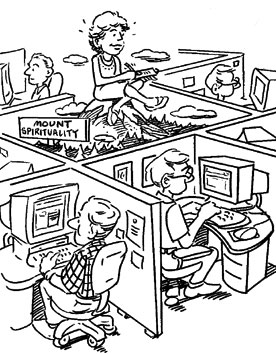Find spirituality in the workplace

Work — a spiritual experience?
Some might find the suggestion amusing, but people can gain greater spirituality and sense of purpose in their work, and organizations can benefit from the potential increase in job performance, says Christopher Neck, associate professor of management at Virginia Tech.
How does Neck study what people think about their work and how it impacts their job performance?
Neck’s conclusions are based on a field study of a training group receiving self-leadership training and a control group that did not receive it. The setting was a company that had filed for creditor protection under Chapter 11 of the Federal Bankruptcy Act. Employees suffered from job insecurity and low morale. The individuals who received the thought self-leadership training experienced increased mental performance, enthusiasm, job satisfaction, and less negative effects compared to those not receiving the training. Spirituality in the workplace is about fulfilling one’s potential and finding a greater sense of purpose in work, where they spend a large amount of time, says Neck, who co-authored an article on the subject for the Journal of Managerial Psychology.
What is my purpose at work or in life? Who am I? Where is this job leading me? What can I offer? What do I want to leave behind? Answers to these questions vary among individuals, Neck says. Workplace spirituality need not mean the same thing to all people. For some, it has a religious connection; for others, it does not. “Core spiritual beliefs often involve a strong sense of community and need to contribute to the betterment of others and society,” says Neck.
He and co-author John Milliman, assistant professor at the University of Colorado, propose a technique called “thought self-leadership.” Using “self-dialogue” and mental imagery, thought self-leadership aims to change employees’ perceptions of their jobs through observing and analyzing their current thought patterns and developing more constructive ways of thinking that can lead to a greater sense of workplace spirituality.
For example, an accountant may believe “all I do is crunch numbers.” Instead of using such extreme “all or nothing” terms, Neck suggests the employee use constructive self-dialogue to reexamine her beliefs. She could ask herself whether there are aspects of her job that she enjoys. She could remind herself that her work contributes to the company’s performance and helps investors make better decisions.
“Employees who rethink their self-defeating internal dialogue may be able to enhance the spirituality of their work,” says Neck. “The accountant, for example, could think: ‘Maybe I need to try seeking more creative ways of doing my job and risk being more honest and open in my communication with my colleagues.’ She could picture herself successfully interacting with colleagues and clients, enjoying the process of preparing an accurate financial statement, and feeling that she is helping her company and its clients.
“This mental visualization should enhance the employee’s perception of her job, as well as her sense of spirituality at work, because she has already experienced this spirituality in her mind,” says Neck.
Also, by viewing her work as an opportunity to reach her potential rather than as an obstacle that prevents her from enjoying life, the accountant will be more likely to see purpose and spirituality in her work.
Thought self-leadership, Neck thinks, will be an increasingly important tool as more businesses move beyond profits to a higher mission, and organizations in general become vehicles through which people can find greater purpose in their lives and contribute to the improvement of society.
For more information, contact Chris Neck at cneck@vt.edu or visit his homepage.
— Written by Sookhan Ho, Pamplin College of Business
Source : www.research.vt.edu




